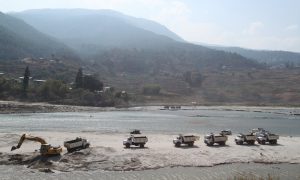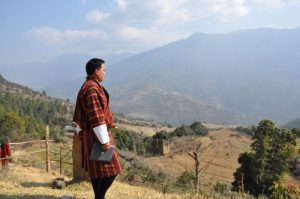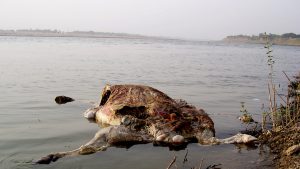Pakistan’s lifeline river Indus is no more a spawning ground for the famous south Asian anadromous fish, the Hilsa (Tenualosa ilisha), known locally as the Palla. Scientists blamed the change in monsoon pattern as a result of climate change.
In most years, for over 300 days out of 365, the Indus does not reach the Arabian Sea any more. Due to this lack of freshwater at its estuary, the Palla no longer goes up the river to spawn.
The result, the annual catch of the fish is now 1% of what it was just two decades ago.
![Palla fish being sold on the roadside near the Indus in Thatta district of Sindh province [image by Amar Guriro]](https://dialogue.earth/content/uploads/2016/04/Hilsa-pak3.jpg)
The significance of the Palla
Fishermen in the Indus delta believe the Palla is a devotee of a Sufi saint, an elderly man with a flowing white beard and holding a rosary; this saint used to travel up and down the river sitting on the back of the Palla. Muslims call the saint Kuwaja Khizir, Hindus Jholey Lal or Udero Lal.
Once upon a time, the story goes, when the Indus used to roar down to the sea during the monsoon, the Palla swam up against the powerful flow to undertake a pilgrimage to Sadh Belo — an island in the Indus near Lansdowne Bridge and the Sukkur Barrage — to pray to the saint.
“But it seems the saint is not happy with the people these days, so he left the island. So the fish too has stopped visiting Indus,” a fisherman of Thatta district in the Indus delta tells thethirdpole.net.
Before the barrages and dams were built, historians have recorded Palla catches as far upstream as Multan, over 1,000 km upstream from the mouths of the Indus.
Traditionally, adult Palla swam upstream from the Arabian Sea into the Indus every March and April — earlier than its cousins in Bangladesh and India. Fishermen waited for them. That Palla catch was considered most important by the fishermen of Sindh, because it earned them more money than they did over the rest of the year.
![Banned gill nets can be seen everywhere in the Indus delta [image by Amar Guriro]](https://dialogue.earth/content/uploads/2016/04/Hilsa-pak2.jpg)
“Production of Palla is directly linked to a healthy delta with continued flows of water in its creeks for almost the entire year at its estuary. But with construction of dams and barrages upstream and diversion of water from the river for irrigation, the Indus delta is not receiving water on a regular basis,” Syed Allah Dino Shah, principal scientist at the National Institute of Oceanography (NIO) Pakistan, tells thethirdpole.net. “So when it is the breeding season, the fish doesn’t find enough water in the Indus estuary to travel upstream. Therefore it has now disappeared from the Indus.”
The Indus has a wide delta — there is the main course of the river plus 17 large creeks, apart from swamps and extensive mudflats. Before the building of the Kotri Barrage, there was a lot more fresh water in this delta, and the Palla often swam upstream through these creeks.
Climate and monsoon
But now apart from the barrage, there is the effect of climate change, which has led to a rise in the sea level and consequent increase in salinity in the estuary. The Indus delta now has a lot of fresh water only by the end of the monsoon, in August or September.
“By August, the breeding season for Palla is over and there is no reason for the fish to enter the Indus,” Shah points out.
According to a study conducted by Pakistan Fisherfolk Forum (PFF), the annual catch of Palla in the Indus has gone down from 18,000 tonnes in 1995 to 100 tonnes in 2014.
Still praying
Even now, every March fishermen in the delta await a fresh flow from the Indus upstream, so they can greet it by throwing rose petals in the water. As part of the tradition, most annual gatherings at local religious shrines also take place in March, and the fishermen gather for special prayers so that they can have a good Palla harvest.
“Once in the past when the river was full of water, fishermen were holding these gatherings and then they were leaving to catch Palla, which they could do only for a few weeks; but it was bringing money for the whole year,” Muhammad Adam Gandharo, a fisherman and an activist for local fisher communities, tells thethirdpole.net.
Talking about the problems now, Gandharo also criticises the gill nets that have such fine mesh that juveniles are trapped as well. There is a ban on the nets, but a ban that is flouted openly.
PFF chairman Muhammad Ali Shah says, “Not just for the Palla but for the survival of the entire delta, we need to allow freshwater flows downstream of Kotri round the year.” Fishermen, he adds, are leaving the delta in search of other livelihoods in cities like Karachi, and the trend would only accelerate unless there was enough water through the year.
![<p>Young fisherman Ali spreads his net in Hajamaro Creek of the Indus delta in the hope of catching Palla [image by Amar Guriro]</p>](https://dialogue.earth/content/uploads/2016/04/Hilsa-pak1-e1595494168899.jpg)





